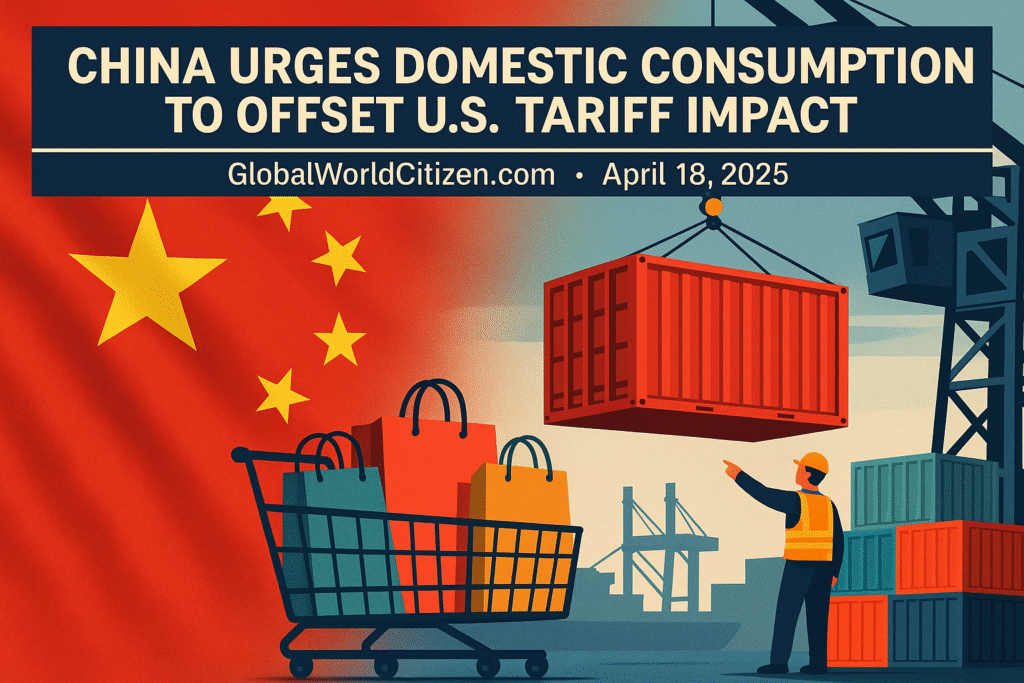Published: April 18, 2025 ✍️ Author: Global Trade & Economy Desk 🌐 Source: GlobalWorldCitizen.com
As U.S.–China trade tensions intensify and global demand weakens, China is turning inward. In a strategic move to mitigate the economic impact of U.S. tariffs and the disruption of global trade flows, Beijing is rallying its domestic market to absorb surplus export goods. The Ministry of Commerce announced an ambitious internal circulation initiative designed to safeguard Chinese exporters and stabilize supply chains under strain.
“The domestic market offers strong backing for enterprises involved in foreign trade,”
— Chinese Ministry of Commerce, April 2025
 E-Commerce Giants Mobilize to Support Export-Driven Enterprises
E-Commerce Giants Mobilize to Support Export-Driven Enterprises
China’s top e-commerce platforms are playing a central role in this economic shift:
-
JD.com has pledged to purchase ¥200 billion (~$27.4 billion USD) in goods originally intended for foreign markets and redirect them through its expansive retail ecosystem.
-
Alibaba, Tencent, and other digital retail leaders are also rolling out nationwide programs to help manufacturers pivot toward domestic distribution.
This move signals a deliberate shift in China’s strategy—from export-led growth to consumer-driven economic resilience.
 Strategic Transition: From “World’s Factory” to Domestic Engine
Strategic Transition: From “World’s Factory” to Domestic Engine
As U.S. import tariffs hit Chinese-made goods—including electronics, textiles, and chemicals—China is reinforcing its internal circulation model. The aim is to:



However, obstacles remain. Consumer confidence in China has been rattled by high youth unemployment, real estate instability, and deflationary pressure.
 Pilot Programs: Redirecting Export Goods to Local Markets
Pilot Programs: Redirecting Export Goods to Local Markets
A nationwide plan is now underway:

-
Machinery & Electronics
-
Chemicals & Pharmaceuticals
-
Apparel & Textiles
-
Processed Foods and Consumer Goods

-
Industry associations
-
E-commerce giants
-
Major supermarket chains
Their shared goal is to initiate “export-to-domestic” sales campaigns and boost household consumption.
 Viral Discounts: From Global Shelves to Local Screens
Viral Discounts: From Global Shelves to Local Screens
Sellers have already pivoted online, slashing prices on Douyin (TikTok China) and WeChat Shops, especially for products originally meant for American consumers. These steep discounts are a sign of mounting inventory pressure due to U.S. order cancellations amid tariff hikes and supply chain decoupling.
 GlobalWorldCitizen.com Insight: A Global Trade Turning Point
GlobalWorldCitizen.com Insight: A Global Trade Turning Point
This development marks a critical transformation in global trade dynamics. As China leans into domestic resilience, key global questions emerge:
-
Will protectionism trigger long-term de-globalization?
-
Can China’s internal market offset losses in the U.S. and EU markets?
-
Will other emerging economies replicate this model?
 Final Word from GlobalWorldCitizen.com
Final Word from GlobalWorldCitizen.com
China’s domestic pivot is more than a national policy—it’s a signal of changing tides in the global world economy. As tariff wars, supply chain realignments, and economic nationalism rise, every Global World Citizen must understand how the rules of global commerce are being rewritten.
Stay with GlobalWorldCitizen.com for global coverage on:







